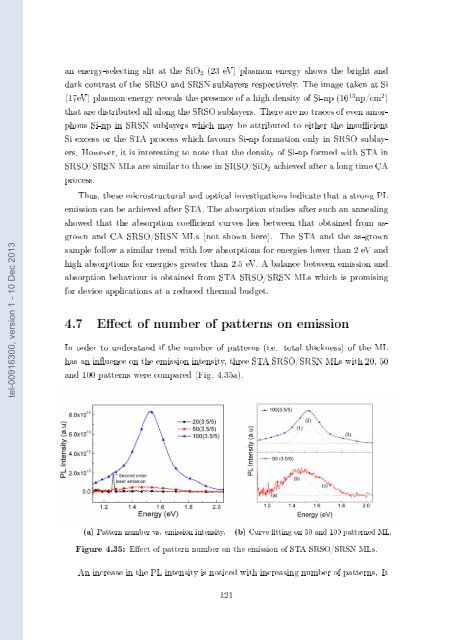Films minces à base de Si nanostructuré pour des cellules ...
Films minces à base de Si nanostructuré pour des cellules ...
Films minces à base de Si nanostructuré pour des cellules ...
Create successful ePaper yourself
Turn your PDF publications into a flip-book with our unique Google optimized e-Paper software.
tel-00916300, version 1 - 10 Dec 2013<br />
an energy-selecting slit at the <strong>Si</strong>O 2 (23 eV) plasmon energy shows the bright and<br />
dark contrast of the SRSO and SRSN sublayers respectively. The image taken at <strong>Si</strong><br />
(17eV) plasmon energy reveals the presence of a high <strong>de</strong>nsity of <strong>Si</strong>-np (10 13 np/cm 2 )<br />
that are distributed all along the SRSO sublayers. There are no traces of even amorphous<br />
<strong>Si</strong>-np in SRSN sublayers which may be attributed to either the insucient<br />
<strong>Si</strong> excess or the STA process which favours <strong>Si</strong>-np formation only in SRSO sublayers.<br />
However, it is interesting to note that the <strong>de</strong>nsity of <strong>Si</strong>-np formed with STA in<br />
SRSO/SRSN MLs are similar to those in SRSO/<strong>Si</strong>O 2 achieved after a long time CA<br />
process.<br />
Thus, these microstructural and optical investigations indicate that a strong PL<br />
emission can be achieved after STA. The absorption studies after such an annealing<br />
showed that the absorption coecient curves lies between that obtained from asgrown<br />
and CA SRSO/SRSN MLs (not shown here). The STA and the as-grown<br />
sample follow a similar trend with low absorptions for energies lower than 2 eV and<br />
high absorptions for energies greater than 2.5 eV. A balance between emission and<br />
absorption behaviour is obtained from STA SRSO/SRSN MLs which is promising<br />
for <strong>de</strong>vice applications at a reduced thermal budget.<br />
4.7 Eect of number of patterns on emission<br />
In or<strong>de</strong>r to un<strong>de</strong>rstand if the number of patterns (i.e. total thickness) of the ML<br />
has an inuence on the emission intensity, three STA SRSO/SRSN MLs with 20, 50<br />
and 100 patterns were compared (Fig. 4.35a).<br />
(a) Pattern number vs. emission intensity.<br />
(b) Curve tting on 50 and 100 patterned ML.<br />
Figure 4.35: Eect of pattern number on the emission of STA SRSO/SRSN MLs.<br />
An increase in the PL intensity is noticed with increasing number of patterns. It<br />
121
















